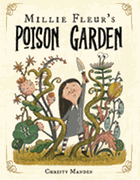
The dare-to-be-different picture book blends beautifully with the kids-to-the-rescue story in Millie Fleur's Poison Garden by Christy Mandin (Lucky; The Storytellers Rule). While Mandin's no-nonsense young protagonist's community-mindedness distinguishes her from Wednesday Addams, in a delightsome touch, their physical resemblance is unmissable: both have long center-parted dark hair and wear white-collared dark dresses and frequently dour expressions. As for Millie Fleur La Fae's frown, she has her reasons.
"Garden Glen was a place of sameness," begins the book's omniscient narrator. Identical houses line the streets--with one exception: a quasi-haunted-looking house on a hill has "no one to love it" until Millie Fleur and her mom move in. Unfortunately, Garden Glen's Rosebud Club is not down with avid gardener Millie Fleur's unusual and wildly blooming buds, like the "Fanged Fairy Moss" or "Sore Toothwart." This prompts the club to flank the property with grumpy signage (e.g., "Neat and tidy lawns only!"). But as it turns out, the kids at Millie Fleur's school have open minds ("Millie Fleur's garden was wonderfully weird!"), and green thumbs to boot.
Millie Fleur's Poison Garden succeeds as a spirited swipe at lazy-brained conformity and leaves readers with much to think about: they may wonder why Millie Fleur and her mom moved to town and whether their paranormal interests--moving boxes are labeled "spell books" and "potions"--indicate that they're witches. Working digitally with a palette that features both earthy and queasy greens, Mandin inserts exquisite visual winks, including Millie Fleur's Venus flytrap paper doll chain and her pet frog's Broadway-big facial expressions, which hilariously mimic the girl's own. --Nell Beram, freelance writer and YA author

